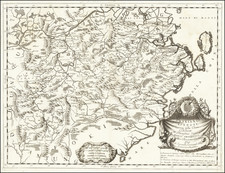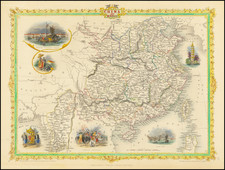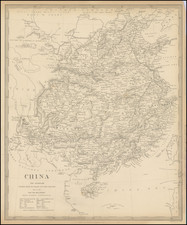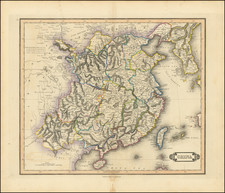He-ong-Kong or Fan-Chin-Cheou
Highly important second state of the earliest printed British Maritime Chart to show Hong Kong. The map also includes a fascinating depiction of Hong Kong Island divided into two islands, with a narrow channel between the two land masses.
The most notable feature of the map is the division of Hong Kong Island, separated by a channel from Shau Kei Wan (Aldrich Bay) to Tai Tam Bay. Talbot surmised that at the time the ship was passing from the north of the island, the visibility was so bad that the hills were not visible and therefore the bay appeared to be a strait. The name "Fan-Chin-Cheou" is unique and does not appear as a name for Hong Kong Island on other maps known to Talbot. He-Ong-Kong was seen by Talbot as a mis-transcription of the Heong-Kong. The shape of Lantao is badly distorted, especially on the eastern side. A number of bays, including Silvermine Bay are not shown, while the peninsula north of Chang Cheou Island is shwn as a separate island. The name "Iron River" is shown for Hebe Haven, perhaps evidence of the chartmaker's knowledge of the iron-ore deposits at Ma On Shan. Mers (Mirs) Bay is shown as being very small. Talbot observed that this was likely additional evidence of the poor visibility, as the many soundings at the entrance to the bay suggest a relatively close inspection of this region.
The map was originally issued by Sayer & Bennett, with the date of November 29,1780, entitled A Chart of the China Sea from the Island of Sanciam To Pedra Branca with the Course of the River Tigris From Canton to Macao from a Portuguese draught communicated by Captain Hayter and compared with the Chinese Char of the Macao Pilots. Captain George Haytor of the East Inda Company was the Captain of the York, which frequented Chinese waters from 1741 to 1787. Haytor is credited with a second printed chart dated 1787.
This second state has been updated by Captains Joseph Huddart and John Pascal Larkins of the East India Company. In his fine article on the first edition of the map, Henry D. Talbot notes that the tracks of the soundings depict the route taken in the initial explorations of the region, which we almost certainly annotating their charts to improve the depiction of the coastline of Hong Kong and the other regions visited. Talbot observes that most of the place names on the map are Romanized versions of the Chinese names, noting that this accounts for the appearance of Botae Island and Lammon. Pengu Chau is mis-named Tay Pak and Siu Kau Yi ans Sui-pak.
Joseph Huddart (1741-1816) was an important and influential English Captain, hydrographer, chart maker, inventor and entrepreneur. Born into the a fishing trade, he first served as seaman then as a master, in 1762 taking command of the sloop Allonby, transporting cured fish to Ireland for the supply of the West Indian markets. His first ship, the Patience, was designed and built by Huddart himself and launched in 1768 for the North American trade.
In 1773, Huddart joined the East India Company, sailing as Fourth Officer aboard the York, bound for St. Helena and Bencoolen. During the course of this voyage he made detailed scientific observations and surveys of the West coast of Sumatra. In 1777, Robert Sayer published Huddart's surveys of the coasts of Sumatra and engaged him to carry out a survey of St. George's Channel, which was completed in summer 1778. His chart of St. George's Channel proved a masterpiece of accuracy and established Huddart's financial fortunes and his reputation as one of England's foremost hydrographers.
In the latter part of 1777 he re-entered the service of the East India Company and was quickly named Captain of the Royal Admiral. For the next decade Huddart sailed the waters between India and China. In 1786 his survey of the Tigris (Pearl River) delta was published by Sayer & Bennett. On his retirement from the sea in 1791 he was much in demand for his advice on harbor improvements, becoming one of the first directors of the East India Dock Company in 1798 and laying the Dock's first foundation stone in 1804. In 1791 he was elected a Fellow of the Royal Society and for 25 years he was one of the Elder Brethren of Trinity House. His scientific acumen resulted in a number of important inventions, including the three arm protractor for hydrographers and the use of high water marks for the London docks, still in use until the 1960's. Perhaps his greatest invention however lay in the development of steam-driven machinery for laying up and binding rope, which he commercialized into a highly lucrative business.
J[ohn] P[ascal] Larkins was a Captain for the East India Company. Larkins was the Captain of the Yap on a passage to Canton in 1787, which located a string of islands (Ngulu) and made other scientific observations. He also produced an account of the passage of the Warren-Hastings by the Macklesfield Strait on the east of Banka in 1788, which was later published by Dalrymple He ultimately settled in New South Wales in the early 1790s and wound up acquiring the home of George Macaulay.
Robert Laurie (ca. 1755-1836) and James Whittle (1757-1818) formed their Fleet Street, London-based firm upon the 1794 death of their employer Robert Sayer, himself one of the dominant print and mapmakers of the last half of the 18th century.
Laurie & Whittle started managing Sayer's business as early as 1787. They took over all managerial duties when Sayer's health flagged in 1792, and they changed the imprint in 1794 upon his death. Sayer left the two a 21-year lease on the shop (at £100 a year) and on Sayer's Bolt Court premises, as well as an option to acquire stock and equipment at a preferential price of £5,000 payable over three years.
Robert Laurie retired from the firm in 1812, and his role was assumed by his son, Richard Holmes Laurie (1777-1858). The younger Laurie worked with James Whittle until the latter died in 1818. After R. H. Laurie died in 1858, Alexander George Findlay, FRGS (1812-1875) purchased the firm from his daughters. The firm continues today under another name, specializing in yachting charts.
Laurie & Whittle were prolific print and map publishers, and throughout their careers, they produced numerous very important and rare works. They carried on Robert Sayer's atlas business and were responsible for editions of The Complete East-India Pilot and The American Atlas.














![(Southeast Asia) [Unpublished Manuscript Sailing Directions from Europe to China by a French Navigational Officer]](https://storage.googleapis.com/raremaps/img/small/90507.jpg)